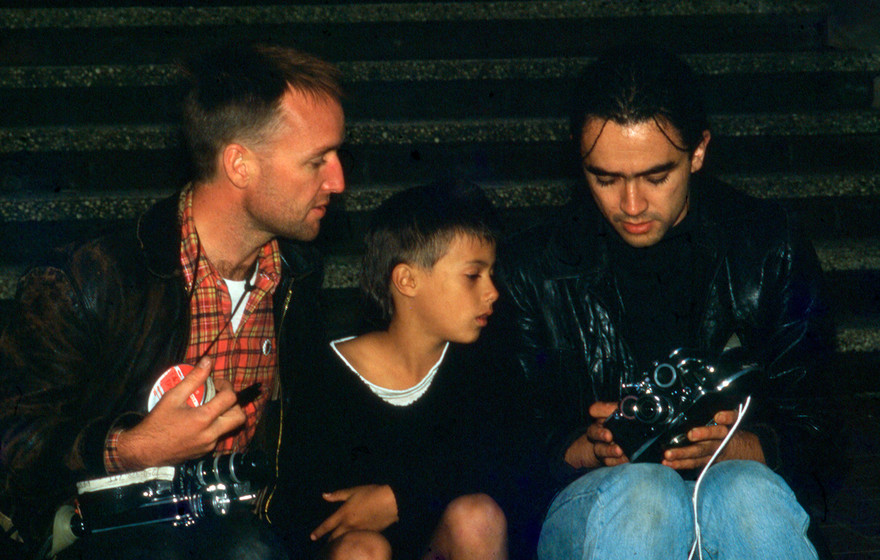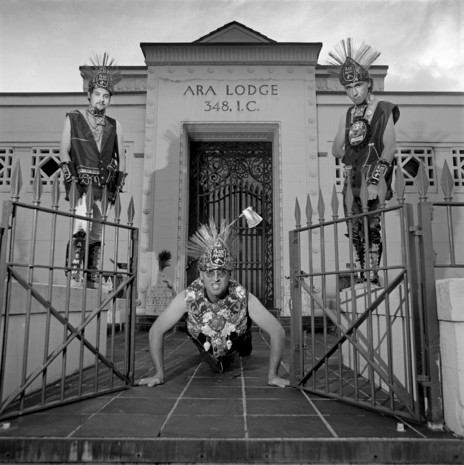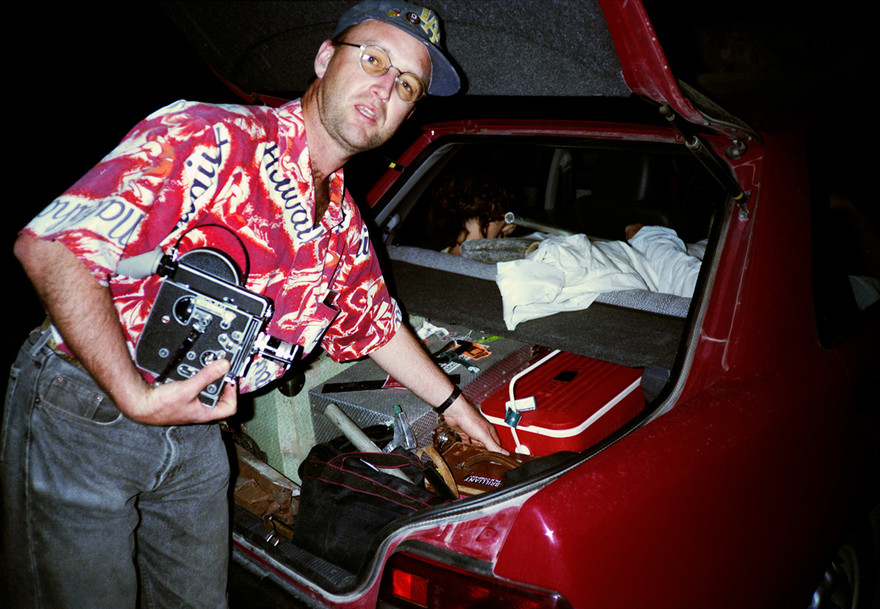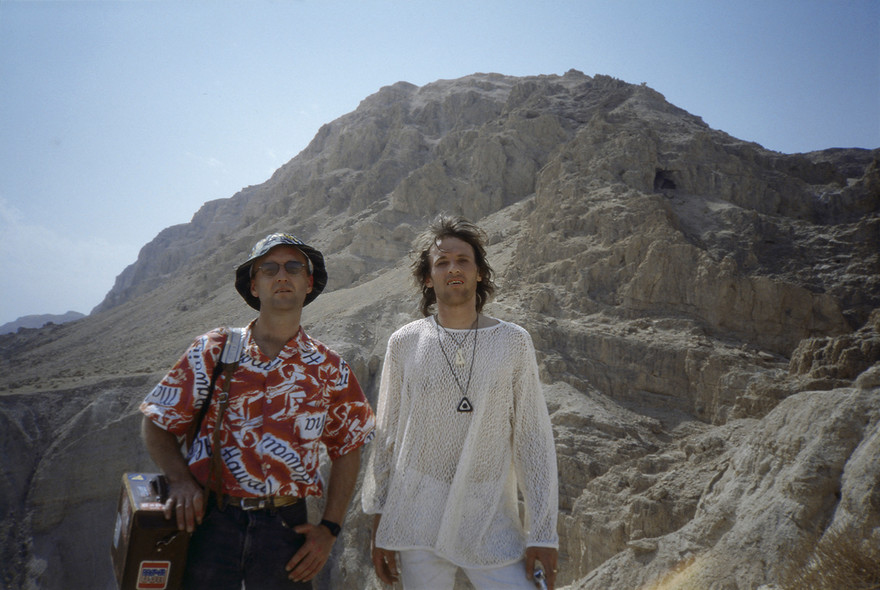Read Stuart Page - part one here.
In the late 1980s Stuart Page moved up to Auckland, and was busy producing cinema advertising for Charley Gray’s and Devonport Cinemas as well as music videos under the banner Eclipse Films. He had also been working with Te Ao Mārama on other productions including the documentary Te Whaea: Mother Of Change, about the kuia Ana Tia who ran an inner-city Tāmaki Makaurau marae focused on helping Māori youth.
He was leasing a beautiful workspace in the old Auckland Harbour Board buildings with views looking out over the viaduct and harbour bridge, but when the AHB wanted the space back he decamped to a more suburban setting: a flat on Anglesea Street in Auckland’s Freemans Bay. Page invited Grant Fell of the Headless Chickens to move in.
“We had a big spare room which we used as a kind of film workshop. The house used to belong to Aardvark Films and Roger Donaldson [of Sleeping Dogs fame] so there was a bit of film history there. Roger Allen [Fogorelli] and Lindsay Fog helped me build the Auckland INK INC studio in the basement – I had been living with them in the Red House for a bit, but I couldn’t handle the chaos – so it was all going on.”

Stuart Page, Daniel, and Grant Fell with Bolex 16mm cameras, Headless Chickens 'Donka' shoot, 1988 - Loren Squires

Stuart Page shooting the video for Snapper's 'Buddy', Taieri Plains, mid-winter 1988. Christine Voice, rear centre, Peter Gutteridge on the right. - Erik Gotlieb
Fell and Page decided to form a film company and came up with Brilliant Films. “It’s a diamond cut so it’s hard and bright,” says Page, “and … so intelligent! We made Flying Nun’s only TV commercial, for the In Love With These Times compilation, as well as film loops for projection at acid-house dance parties.”
Their long nights conducting the time-lapse and matte box experiments to feed the beast that was the Headless Chickens ‘Donka’ video are a product of the Anglesea Street live-in lab environment. A perfect marriage of music to surreal, kaleidoscopic imagery, it exemplifies the peaking wave of a particular flavour in urban Aotearoa’s burgeoning post-punk/art rock scene, and along with 1990’s Grant Fell-directed ‘Gaskrankinstation’ marks a fruition of the dark Chris Matthews’ machinations that began with Children’s Hour in 1982.
Like ‘Donka’, Page’s video for Snapper’s ‘Buddy’ transcends the pop video idiom and steps effortlessly up into some other realm. Unlike the former’s wild collage, the body of the film was shot on the freezing cold Taieri Plain and featured the band tearing through the darkness at the edge of town in the company of Dunedin’s anti-helmet-laws club The Bikers’ Rights Organisation Of New Zealand. Intercut with psychedelic scenes of the band shot in Christine Voice’s studio space and excerpts from a famous movie, the clip’s Kenneth Anger/Scorpio Rising vibe gels perfectly with this great example of Snapper’s menacing sound. ‘Buddy’ is Snapper’s only music video; that’s okay because one perfect clip is sometimes enough.
You could say the same for S.P.U.D.’s singular music video, 1989’s ‘Breakdown Town’, which found Page embracing new digital technology at Auckland’s Electric Pencil in the form of the Qantel Harry effects compositing system. While it was a great opportunity to use cutting-edge tech, the suite proved way too popular with the advertising crowd. “It took like a year to make,” he says. “Even at night it was booked out. Sometimes someone would cancel, and I’d get a 10pm start, do a night and then have to wait for three weeks or a month for the next available slot.”

Stuart Page with his band AXEMEN at the Ara Lodge No 348 I.C., Airedale Street, Auckland, 1990, - Paul McCredie
Around this time filmmaking couple Geoff Murphy and Merata Mita were giving local artists like Page low-cost access to Lightworks at their ORA Digital suite in Herne Bay. This was the first non-linear edit (NLE) system in New Zealand, an invaluable resource that helped facilitate numerous short films and music videos.
In 1989 Page also took part in The 1990 Project, in which the Auckland Public Library under the management of Paul McCredie commissioned him and four other photographers, Chris Matthews (no, not the Headless Chickens musician), Ans Westra, Miles Hargest and McCredie, to document life in the city on the 150th anniversary of the signing of Te Tiriti. Page ventured into the heartland of Tāmaki Makaurau’s industrial suburbs and produced hundreds of images ranging from candid street photography to more formally framed portraits, all of which he submitted rather than picking out the “best” ones. In 2024 many of these images have seen the light of day on the excellent “Timespanner” Facebook page, where they have connected in a big way with the community at large. (Over 6000 of the images, from all five photographers, are permanently on the Auckland Library’s heritage website Kura. Among them are 1200 by Page.)

The graffiti artist known as MANIAC on Sandringham Road (Auckland Libraries Heritage Collections 273_PAG043_08) 1989. - Stuart Page
Butthole Surfers
When US band The Butthole Surfers came to Auckland in 1991 to play two consecutive nights at the Powerstation, promoter Doug Hood gave Page a call and asked if he wanted to handle projection duties.
“They stipulated it had to be Xenon Superbright projectors with cinemascope lenses, very particular high-end requirements. I met Gibby [Haynes, vocalist] and he hands me a big stack of films, they are all from the library of such and such, Arizona, United States Military … you know, ‘liberated’ films. There’s penis surgery, VD films, Russian military parades, Charlie’s Angels … and he says just play whatever, any order you want, and that was that.”
Page played all of the more extreme footage at the first show, while the second featured wildlife documentary material. This might sound like a family-friendly presentation, but the spectacle of Gibby howling into his microphone while a massive hawk captures and eviscerates its prey in slow motion behind him is forever burned into this writer’s retinas.
David Kilgour
In 1989 David Kilgour bought a Revox tape machine, and in 1991 Flying Nun released his first solo album, Here Come The Cars, a collection of blissful melodic tunes wielding razor-sharp lyrics. Over the next couple of years Page directed three videos for songs from this and David’s next solo album, 1994’s Sugar Mouth.
“Mushroom had just taken over Flying Nun. And suddenly they had big chunks of money for music videos. I had two $10,000 budgets. I looked at David and said ‘Fuck why don’t we just fly out to Mexico and make them over there?’ And we very nearly did …’’
Luckily not, as this series of clips are stone-cold New Zealand classics. ‘Beached’, from Sugar Mouth, was shot mostly on location in St. Bathans in Central Otago, around the mining-industry tailings piled up around the lake which is itself a by-product of the industrial interventions.
“The song is about alienation in the social sense, but we thought we’d make it literal so the character is an alien that’s crashed onto the planet. We stayed at the Vulcan Hotel which is apparently haunted, and the proprietor was a Lou Reed fan. That’s all he played in the bar, just Lou Reed. Hamish [Kilgour] happened to be in the country, so he came along as our grip. Hamish, Lou Reed, haunted … perfect.”
Hamish claimed to have had a nocturnal visitation from the hotel’s resident spectre, but may well have been influenced by the proprietor having wired the hotel with hidden speakers that fed eerie sound effects throughout the premises. “We could hear occasional laughter coming from inside the locked wardrobe in Hamish’s room …” The clip’s bleached-out look wasn’t a post-production grading choice, Page had decided to shoot the whole thing over-exposed a few stops. Risky, but ultimately rewarding.
From the 1991 Here Come the Cars album, ‘You Forget’ is another audio-visual indie-pop gem. David drives through Auckland’s Cornwall Park, across Grafton Bridge, then catches a ferry over to Rangitoto and back. There is some underwater singing in the shallows of Karekare beach that segues into a nice psychedelic sequence, and some flickering time-lapse footage of the trips across the Waitematā Harbour that hark back to The Clean’s first clip for ‘Anything Could Happen’ a decade earlier. David drives that 1966 Buick Riviera around town like he owns it.
“The car belonged to Keith Kahi, who died under nefarious circumstances when he took a knife to a gunfight. He had his Supercar workshop in Galatos Street just along from the rear entrance to the Red House. He’d figured out if you took the engines out of classic cars in the US and put the engine in one container and the body in another, you could import them as spare parts.”
Also from Sugar Mouth, ‘No, No, No’ is a tongue-in-cheek look at the glamorous jet-setting lifestyle of the Flying Nun glitterati in which scenes of David being crowded by paparazzi at Auckland Airport and traversing nighttime cityscapes in a sunglasses-at-night limo with Martin Phillipps (The Chills) as chauffeur are intercut with gig footage from Auckland’s Powerstation. The party scenes feature Hamish Kilgour and Christine Voice (Snapper), and Sharon Billesdon and Peter Elliott as David’s minders.
In 1992, Festival Records (NZ) released Stuart’s Noisyland VHS compilation of mostly self-funded music clips from the 1980s. Curated and produced by Page and edited by Craig Miller, it seemed this tape, which was chock full of classics from Page and others, could be found next to the TV in every inner-city flat throughout 90s Aotearoa.
The year after, Page filmed the Karyn Hay-directed clip for Andrew Fagan’s song ‘Jerusalem’ on location in Jerusalem and the Dead Sea.

Stuart with his wind-up Bolex 16mm movie camera in Jerusalem, Israel, 1993. - Andrew Fagan

Stuart and Andrew Fagan near the Dead Sea, Israel, during the 'Jerusalem' music video shoot, 1993
Downhill Racer (1996)
Page crewed on films during the late 90s including A Soldier’s Sweetheart (1998) and Nightmare Man (1999). “I’d started working in the film industry doing lighting and was so busy that I often couldn’t make it to gigs and rehearsals,” says Page, “so Rich [Rich Mixture – The D4, The Rainy Days] jumped in on drums with Shaft. But I’m playing on the recording of ‘Downhill Racer’. Bob Cardy asked me to make the video, and when I asked him what the song’s about, he said, ‘It evokes the enigma of life as we know it … let’s drive a truck through a house!’ It was actually a Volvo generator truck that belonged to Keylight, one of the companies I did lighting for, but it looked a bit too shiny, so we draped an army camo net over it.”
The interiors are filmed on sets designed and constructed by Kerry Hessel at Main Artery, a studio on Coles Avenue in Mt Eden. This studio had been utilised in countless productions through the 80s, and the space was taken over by Steve Morrison in the mid 90s for a further run of notable music videos. If the TVNZ/Avalon/short-ends period was the first heyday of local music videos, the mid-90s NZ On Air $5000 music video grants period must surely be the second (it overlapped with a voluntary New Zealand content quota applied to radio stations and saw a decline in our mainstream audience’s cringe-culture in regards to local sounds).
Page’s clips for indie-pop trio Superette’s songs from their 1996 album Tiger were high-rotate hot potatoes on Max TV, Auckland’s popular music TV channel. Dave Mulcahy’s post Jean-Paul Sartre Experience outfit with Greta Anderson and Ben Howe were aided onscreen by various mates in these productions, with Simon Cuming stealing the show in comic roles including a standout performance as a frustrated peep-show patron in the video for ‘Touch Me’.
Page also squeezed in videos for The Clean’s ‘Outside The Cage’ from their 1994 Modern Rock album and ‘Twist Top’ from the 1996 album Unknown Country. According to the footnote on Stu’s Noisyland YouTube channel, “‘Twist Top’ is a Hamish-penned song filmed in his absence in Auckland on a shoestring budgie on Kawowski’s trusty Bolex.’”
In 1999 Page collaborated with fellow Moog Media partners Andrew Moore and Stephen Sinkovich, shooting 16mm timelapse on a clip for the song ‘Ode To K’ Rd’ by Auckland’s Peter Stuyvesant Hitlist.
Moana and The Tribe
Page was shooting and editing some docos for Moana Maniapoto around the time she decided her Europe-bound live act really needed a video component to help get the message across. The shows were imminent, so he put his hand up and made 20 song-specific clips in two weeks, then was invited on the tour.
“I went off to Europe with just a DVD player and a projector, I didn’t have any sort of mixer or anything. But it went down really well, everyone loved the videos, and between 2002 and 2006 we did four European tours.”
They developed a flexible touring kit that included portable screens and a vision mixer, and Page often routed his return flights through the US so that he could collect the interviews he needed for his first documentary.
Shustak (2009)
Page’s inspirational mentor Larence Shustak was sceptical that anyone would ever fund a documentary on himself, but Page received word that funding had come through on the day in 2003 that he helped carry Shustak’s coffin (he had suffered a heart attack some months earlier). Page had captured some interview material from the recalcitrant artist and thought he would make a small, intimate film, but the project grew when Americans such as Elliott Landy (Woodstock photographer) and Harvey Zucker from A Photographers Place bookstore got wind of it and urged him to expand the concept.
For the Scope website, James Robertson wrote, “Shustak reveals the man as artist, teacher, friend, father, husband, provocateur, agitator, character. This documentary brings together the teacher and student with a unique eye for the interplay and scope between image and text.” Along with the Best Emerging New Zealand Filmmaker award, it won the Best New Zealand Feature award at the 2009 DocNZ International Documentary Festival of New Zealand.
All that international travelling had prompted new ideas for moving image and photography work, culminating in an exhibition at Anna Bibby Gallery in 2009 titled EAST/WEST. It combined three of Page’s works into one audiovisual presentation, WARPORNUSA (2004), Code Orange in the Big Apple (2005), and Otaku Octopus (2006). Says Page, “Robert Leonard from Artspace was a fan of these works, and was instrumental in making that happen, introducing me to Anna and pushing it along.”
2009 also saw Tom Lax at Siltbreeze Records in Philadelphia reissuing AXEMEN cassette-only albums Big Cheap Motel and Scary Pt. III on vinyl, and the band were invited to tour the US, opening for Times New Viking on 26 dates.
When Jim Wilson returned to New Zealand in 1992 and regained control of Phantom Billstickers, Page stepped up and helped with various media needs. He designed their ubiquitous bulldog logo and made videos of their various exploits, and in 2012 – as part of Phantom’s poetry posters project – he and co-director Bridget Sutherland accompanied eight New Zealand poets to New York to document them reading in various locations, which can be seen in their film The Story Of The Poetry Poster.
Around the same time Page shot and edited the video for the song ‘Wonders’ from the Bilders, documenting a bicycle ride across New York City’s Williamsburg Bridge a couple of days after Hurricane Sandy swept through. The song, on which he also played drums, was released in late 2012 on a clear perspex lathe-cut 7-inch by OneC Records in the UK.
How Bizarre: The Story of an Otara Millionaire (2014)
This Stuart Page-directed documentary begins with a high energy sequence recapping the waves of international chart success of the titular song and its magnetic singer and co-writer Pauly Fuemana (OMC). It then settles into a series of intimately framed interviews with family, friends, collaborators and music industry players, to paint a nuanced and sympathetic portrait of a man whose journey as an artist was tragically cut short by a rare form of multiple sclerosis in 2010.
The documentary also stands as a tribute to the combined talents and teamwork of Page and co-producer/cinematographer Fred Renata. “Fred was once my neighbour, and we became friends. I invited him to the test screening of Shustak and he really liked it, so when he decided to co-produce a film with William Grieve about his friend Pauly he approached me to direct it.”
Renata had found a broken handycam among Pauly’s stuff, and had to take the housing apart to extract the tape. The only thing on it was a video for his love song ‘Tropicana’, shot in consummate selfie-style well before there was such a thing. It’s the last visual record of him before he passed away, and it plays over the end credits of the film, which won a Prix Spécial du Jury at the 2017 FIFO International Oceanian Documentary Film Festival (Tahiti).
Gutteridge/SMF
“In 2014 Peter Gutteridge came to my house with no bookings or passport and said he wanted me to drop everything and go with him to America, like the next day. I had to say sorry, I can’t. Off he went, and then what happened, happened.”

Peter Gutteridge after collecting his first New Zealand passport the day before departing to the United States; downtown Auckland, 16 August 2014 - Stuart Page
Arriving unannounced, Gutteridge hoped to hook up with The Clean who were touring the US, but things didn’t work out. He played one night in Brooklyn with a makeshift band and returned to New Zealand disillusioned and the worse for wear. “Later Chris Heazlewood and I learned he was back in the country, in a psych ward at Middlemore Hospital, so we arranged to visit him,” says Page. “He was acting quite strange. We went out again a day or two later with a care package, but he just wasn’t interested and was acting very dark. As we left, he said ‘You two guys are serious motherfuckers!’
“We expressed our concern to the staff, that they should keep a watch on him, but he died that night.” Some time later, Page and Heazlewood were invited to Dunedin to attend an inquiry into Peter’s death. To pay for the trip, the pair booked a guitar-and-drums gig in Christchurch at the Darkroom under the moniker SMF, and a follow-up at The Crown in Dunedin, both with Page DJing vinyl and poet David Merritt on the bill. A few months later, an Australian promoter booked SMF to play the Paddock Bash event outside Melbourne.
Hamish Kilgour
Page had played live with Hamish Kilgour on odd occasions in New York, but it was always casual. “We had a gig in Auckland on the day of the big Christchurch earthquake. Hamish had just turned up from New York, I went to have a rehearsal with him and Danny Mañetto and – as I was leaving home – a flatmate called out that there’d been another earthquake. As I arrived at Danny’s I received a text from Rosie my mum saying ‘I’m okay!’ I was mystified so I asked Danny to turn on the TV, and there’s the cathedral spire falling into the square. We had to do the gig that night and Hamish still hadn’t been able to get in touch with his mum Helen, so we were standing on stage frantically tapping away at our phones, while the audience waited for us to play … that was pretty wild.”
The trio toured more extensively throughout New Zealand twice in 2019. “Hamish turned up at my place and handed me a little black and white biro sketch, a very thoroughly drawn design that read ‘Finklestein: featuring Hamish Kilgour, Stuart Page and Daniel Mañetto’, and says, ‘Oh yeah, we’re going on tour!’ So I prepped the artwork, turned it into a poster layout and sent it off to Phantom Billstickers who’d agreed to do some posters for us.”
That first tour saw the trio freewheeling their way around the country with little planning, relying on word-of-mouth and momentum to spin one gig into another (helped along by Phantom and Brian Wafer, who would print posters in short order as shows materialised). The follow-up tour managed by Mañetto was quite the opposite, with tight scheduling seeing them traverse the country multiple times. Always an unpredictable and creative spirit, Hamish preferred to perform in the moment. “No set list, no rehearsal, and a lot of his songs have a Coney Island Baby/Lou Reed vibe, so it could be one or another song that you’re playing, not too sure which one it is when you start out.”
Based around a story written for his son Taran, the Finklestein/Funklestein duo of albums were released in 2018 with a remix album Franklestein following in 2019. Hamish died unexpectedly in Christchurch in 2022.
The Celia Mancini Tapes (Leap Decade Records LD 001- 2018)
Page got involved with the Celia Mancini compilation when the project was already well underway. He says, “Celia and Glen Brewer had started collecting together all her tapes, a lot of them were on cassette, and they had finalised the track listing before she died (Celia passed away in 2017).

The Celia Mancini Tapes (2018)
“Simon Gottlieb was involved with digitising, and Glen was ultimately managing the project. I met up with him and Lindsay [Fog] and then got busy on the LP jacket design and info, there’s a lot of detail there because every song has a different line-up, so I spent quite a few months just researching who the hell was on which one. It’s really important to me that all of that information is correct, there’s nothing worse than someone else getting credit for your work. Acknowledgement is a biggie.”
Stevie McCabe: Mourning Of Youth

Steve McCabe recording vocals, Derry Legend sessions, at Skeptics' Writhe Recording, Wellington, 1987. - Stuart Page Collection
One year on from Stevie McCabe’s death in September 2023, Page teamed up with Matthias McGregor of Christchurch label Leather Jacket Records to release a Stevie McCabe memorial AXEMEN record. “We’ve chosen ‘Mourning of Youth’ as the main song with ‘Hey Alice’ on the flip side, it’ll be coming out as a seven inch. It’s got an insert in it with the whole story about Kurt Cobain coming across us playing on the rooftop at a Frisbee Studios party on Mayoral Drive, then going out and buying our record. People thought we were bullshitting for years until [Cobain’s posthumous] Journals came out and there it is.” The record had a launch party at the Leather Jacket-managed Flying Nun shop in Christchurch in June 2024.
Since 2005 Page has made music videos for a long list of artists including Ghost Wave, Shaft, DOG Power, and Princess Chelsea. In 2023 he collaborated again with Roger Allen/Fogorelli, this time designing the artwork for the Leather Jacket Records release of Riot 111’s album 1981!, a compilation LP of singles and other tracks from the legendary Wellington punk outfit.
“Commercial artist” used to be considered a derogatory term, but Stuart Page’s tradesman-like attitude towards his creative endeavours is a good fit for Aotearoa’s sensibilities, and it’s got something of the drummer/engine room vibe to it too. His old mate Danny Mañetto reckons Stu’s no-nonsense, “screw it, let’s do it” approach to the arts has been key to his success in making a living doing the things he loves. He shows no sign of letting up any time soon, so if you want to keep up, I recommend bookmarking his YouTube channel and stay tuned for further instalments.
--
Stuart Page’s YouTube channel, Noisyland